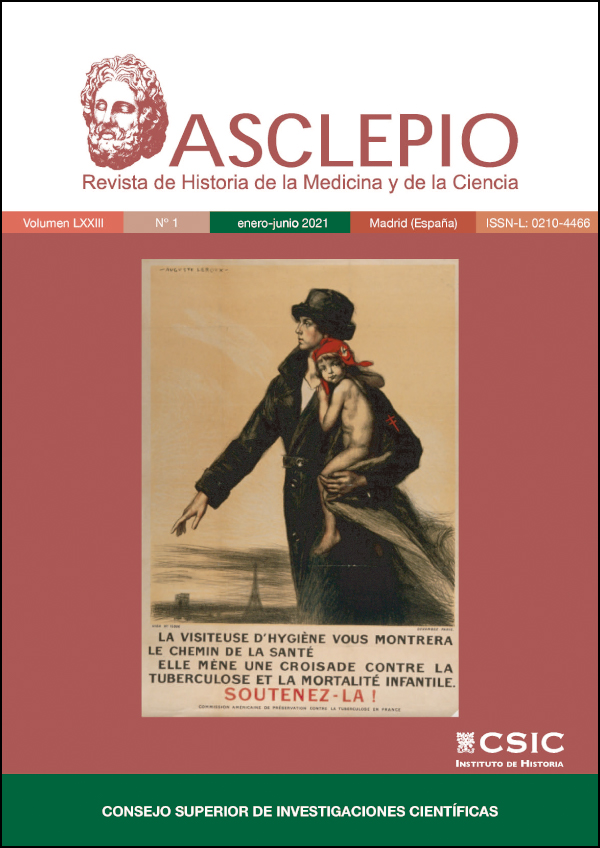Newton's Scala Graduum Caloris. A Numerical Simulation
DOI:
https://doi.org/10.3989/asclepio.2021.16Keywords:
Newton, Cooling, Thermometers, Scales, SimulationsAbstract
Sir Isaac Newton, in the Scala graduum Caloris, published in 1701, presented a scale with “the degree of heat” of the bodies which extended the measurements far beyond the values available at that time. To determine it, Newton followed two paths. The first was by using an expansion thermometer with linseed oil as the liquid, whose measurements followed an arithmetical progression, but its maximum was limited by the inflammation of the oil. The second using a completely new method, which consisted of measuring the cooling times of a body previously heated in a small kitchen fire, and relating these times to the temperatures according to a new law, which gave rise to a new scale that followed a geometric progression. Both scales were partially overlapped, allowing him to extend the arithmetic measurements up to more than six times the water boiling point. This new law is known as Newton’s Cooling Law.
Here, we intend to carry out a numerical simulation of the hot body cooling process, conjecturing the instruments he may have used and the environmental conditions in which it took place. All this following what Newton himself reflects in his article. We will end with some reflections on the law, which we believe he enunciated in an integral manner.
Downloads
References
Benson, Ugo (2010a), The History of the Cooling Law: When the Search for Simplicity can be an Obstacle, Springer Sicence+Business Media B. V. https://doi.org/10.1007/s11191-010-9324-1
Benson, Ugo (2010b), "Cooling and warming laws: an exact analytical solution", Eur. J. Phys. 31, pp. 1107-1121. https://doi.org/10.1088/0143-0807/31/5/013
Brewster, David (1831), The Life of Sir Isaac Newton. Harper & Brothers, New York.
Brewster, David (1855), Memoirs of the Life, Writings, and Discoveries of Sir Isaac Newton, vol. 2. Edimburgo.
Cohen I. B. (1958), Isaac Newton's Papers & Letters On Natural Philosophy, Harvard University Press, pp. 259-269.
Desaguliers, J. T. (1744), A course of Experimental Philosophy, Vol. II, Londres
Dobbs, B. J. T. (1975), The Foundations of Newton's Alchemy, Cambridge University Press.
Grigull, Ulrich (1984), "Newton's Temperature Scale and the Law of Cooling", Wärme und Stoffübertragung, 18, pp. 195-199. https://doi.org/10.1007/BF01007129
Higgitt, Rebekah (2007), Recreating Newton. Newtonian Biography and the Making of Nineteenth Century History of Science, Pickering & Chatto Publishers. Londres.
Newton, Isaac. Principia. Traducida al inglés por Andrew Motte's (1729). Revisada por Florian Cajori. University of California Press, 1934.
Newton, Isaac (anónimo). "Scala graduum Caloris. Calorum Descriptiones & signa", Phil. Trans, 1700-1701, vol. 22, pp. 824-829. https://doi.org/10.1098/rstl.1700.0082
Patterson, Louise Diehl (1951), "Thermometers of the Royal Society, 1663-1768", American Journal of Physics, 19, pp. 523-535. https://doi.org/10.1119/1.1933073
Robert M. Sayre, Norman (1963). "The 'Scala Graduum Caloris' and Sir Isaac Newton", Proc. Of the Okla. Acad. Of Sci. for 1962. Vol. 43, 1963, pp. 198-202.
Ruffner, James A. (1963), "Reinterpretation of the Genesis of Newton's 'Law of Cooling'", Notes and Records of the Royal Society, 18, pp. 138-152. https://doi.org/10.1007/BF00357652
Published
How to Cite
Issue
Section
License
Copyright (c) 2021 Consejo Superior de Investigaciones Científicas (CSIC)

This work is licensed under a Creative Commons Attribution 4.0 International License.
© CSIC. Manuscripts published in both the print and online versions of this journal are the property of the Consejo Superior de Investigaciones Científicas, and quoting this source is a requirement for any partial or full reproduction.
All contents of this electronic edition, except where otherwise noted, are distributed under a Creative Commons Attribution 4.0 International (CC BY 4.0) licence. You may read the basic information and the legal text of the licence. The indication of the CC BY 4.0 licence must be expressly stated in this way when necessary.
Self-archiving in repositories, personal webpages or similar, of any version other than the final version of the work produced by the publisher, is not allowed.















